FOUNDATIONS REVEALED COMPETITION ENTRY

Skogsrå
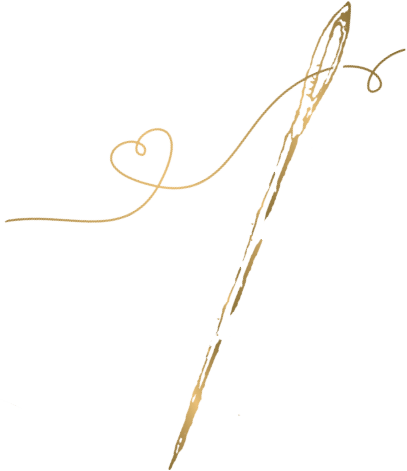
Outline the story …
In Sweden and a few of the other Scandinavian countrys there is a mythical creature in the forest that people believed existed in the old days, and maybe she does! The Skogsrå, meaning keeper of the forest, is a woman who guards the forest and all it’s animals, keeping them safe. She is beautiful and is often depicted with horns and although very beautiful if you see her from behind you will see that her back is that of a hollow tree trunk. She brings good fortune to those who encounter her, if they treat her right! If not she will become dangerous and the hunter who angers her will never again hit his target and might even get lost in the woods forever. She is known to lure men closer and suduce them. This is how I imagine the 18th century Skogsrå would look like and I choose the green color of the fabric as I thought it was suited for a forest being.
Outline the construction…
I first made the stays, and I drafted the pattern using the arc method. I did not need to make any fit alterations so they are basically the mock up being the final garment. The stays are made of cotton canvas and I used synthetic whalebone for boning. The front has false lacing thats not ment to be opened, the front also have a bustrail (boning going horizontally across the chest on the inside.). I made a wooden busk that I sanded to a sligthly triangular shape in front, that sits inside a buskpocket I sewed to the lining by hand befor putting the lining into the stays. The stays are lined with cotton lawn as I had alot of that in my stash and I live in a cold climate so I thought it would due instead of more expensive linen fabric. The channels are machine sewn but other things are hand sewn, the eyelets and the joining of some panels and the lining is also hand sewn to the stays for example. For the robe I was inspired by an extant dress drawn in Norah Waughs book ”cut of womens clothes” a 1740-1750 robe a la anglaise. I used a green cotton sateen for outer fabric and a unbleached cotton lawn from my stash for lining, I hand sewn eyelets in a thick linen thread as a inner closure of the lining, the robings then closes with pins over the stomacher (that is pinned to the stays.). I drafted the pattern to my measurments and started by fitting the lining on myself, I then pleated the back of the gown to fit the lining and machine sewn them down. I folded the robings and adjusted them on my body while wearing the undergarments and whipped them in place from the inside. The sleeves are lined and handsewn with a back stitch to the robe, I also made flounces that I trimmed with a narrow gold colored lace and machine sewed to the sleeves. The engegants are machine embroidered lace that I gathered in two rows to a tape and fastened with pins. The pouf trims on the robes skirt part are long tubes that I sewed trims to and with great difficulty stuffed with cotton and then hand sewn into small pouffs, it was quite a challange to get the stuffing into the narrow tube and to get it even distribuated, it took forever! I then hand sewn them with a whip stitch to the gown, the other trim I made is a long gathered trim that runs over the robings and around the neck, that I machine sewn down. I made some stitches by hand on the inside keeping the pleats of the robes skirt part together to prevent it from colapsing over the pouf trimmed area. The stomacher has a compleatly boned foundation in canvas and the outer fabric is trimmed with applique. The hem of the robes skirt is folded over one cm to hide the raw edges and then folded over once more to the inside about 15cm and handsewn i place with tiny whip stitches only catching one or two threads of the fabric. The skirt is cut in two rectangles and I did (not historically accurate) french seams for the side seams, the splits on the sides for reaching the pockets and putting the skirt on I folded over twice and machine sewed in place. I made a ruffle for the skirt and trimmed it with the same pouf trim as the robe, after hemming the skirt by folding it over twice to the inside and making sure the hem of the ruffle matched the hem of the skirt, I finished the raw top edge of the skirt and pleated it with a box pleat in center front and knife pleats on each side of that and on the back two inverted box pleats on top of eachother followed by knife pleats, to fit my waist, I then folded the pleated top down whiled keeping the pleats in place with a basting stitch I made before and sewed the front and back onto their twill tape waist bands by hand, I then removed the basting and the leftover fabric on top on the inside acts as an extra pouf. The panniers are made of cotton lawn and boned with spring steel that I sanded round and smooth and covered with electrical tape to keep the edges from finding its way through the boning channels, its about knee length and I drafted the pattern from a costume book. The shift is made of an old bed sheet and I drafted the pattern from a costume book, its machine sewn. When fitting this gown I found the shoulder part being the most difficult (as always.) it took alot of putting on and taking off and replacing the pins before I was satisfied. I finished the raw edges of the robings on the inside by folding them and whip stitching them to the lining.

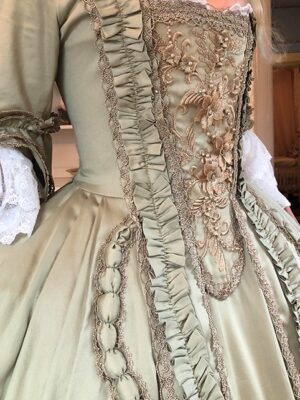
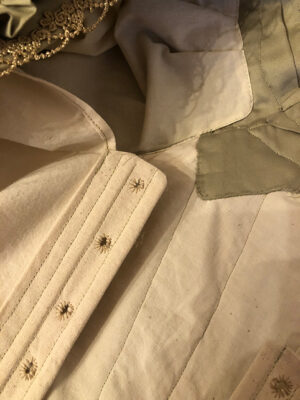
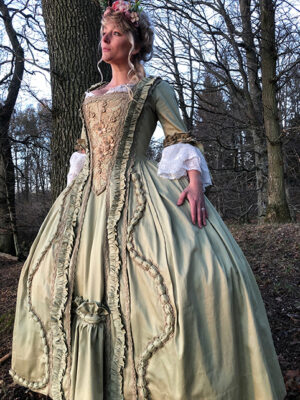
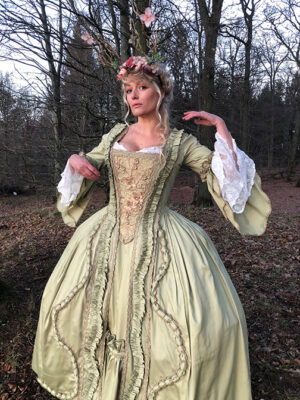
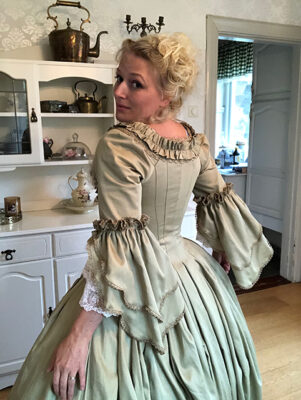
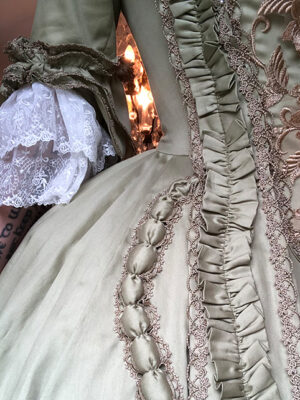
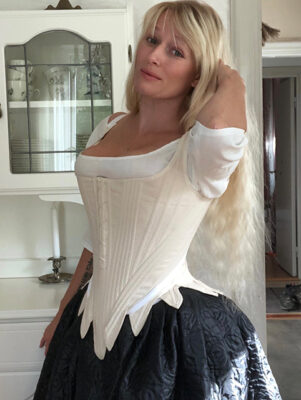
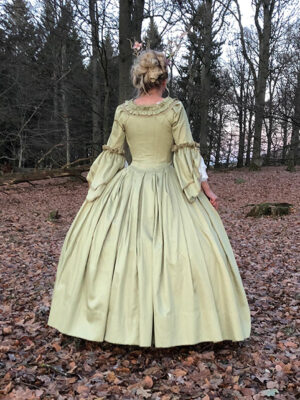
This is so pretty, I love the colour you picked and the details. Great work.
Thank you for your kind words 🥰
I love the 3d effect of the embroidery